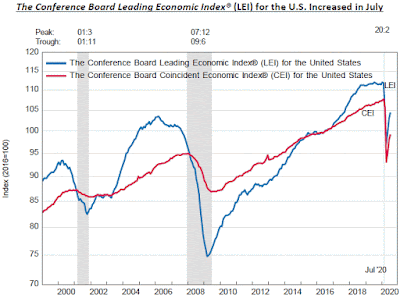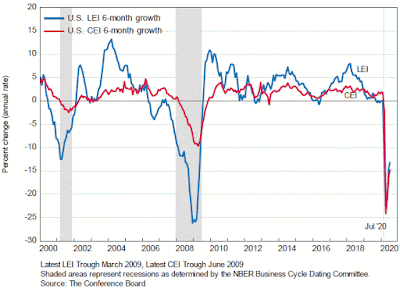Consumer Sentiment: Final Results for August 2020
Predicted: 75.0
- Actual: 74.1
- Change from Previous Month: +2.207% (+1.6 points)
- Change from 12 Months Previous: -17.483% (-15.7 points)
=========
- Final ICS Reading for July 2020: 72.5
- Final ICS Reading for August 2019: 89.8
=========
From today's report:
"...Consumer sentiment has remained trendless in the same depressed range it has traveled during the past five months. The August figure posted an insignificant gain of just +0.4 Index points above the April to July average. The small August gain reflected fewer concerns about the year-ahead outlook for the economy, although those prospects still remained half as favorable as six months ago. The pandemic has created distinctive consumer reactions to the economy.
Since the April shutdown of the economy, a sizable number of consumers thought conditions could hardly get any worse. The natural response was that economic conditions would improve given the absence of any negative economic causes for the recession. For example, while nine-in-ten consumers viewed the current state of the economy negatively in August, half of all consumers anticipated the economy would improve in the year ahead.
Although half anticipates an improved economy, when asked to judge the performance of the economy, 62% judged that the overall conditions in the economy could be best described as unfavorable. Although strong gains in consumer spending from the 2nd quarter lows can be anticipated, those gains will significantly slow by year-end without some additional fiscal spending programs to diminish the hardships faced by unemployed workers, small businesses, as well as support for state and local governments..."
=========
The ICS is derived from the following five survey questions:
- "We are interested in how people are getting along financially these days. Would you say that you (and your family living there) are better off or worse off financially than you were a year ago?"
- "Now looking ahead, do you think that a year from now you (and your family living there) will be better off financially, or worse off, or just about the same as now?"
- "Now turning to business conditions in the country as a whole, do you think that during the next twelve months we'll have good times financially, or bad times, or what?"
- "Looking ahead, which would you say is more likely: that in the country as a whole we'll have continuous good times during the next five years or so, or that we will have periods of widespread unemployment or depression, or what?"
- "About the big things people buy for their homes, such as furniture, a refrigerator, stove, television, and things like that. Generally speaking, do you think now is a good or bad time for people to buy major household items?"
- Click here for more on how the ICS is calculated.
=========
The ICS uses a 1966 baseline, i.e. for 1966, the ICS = 100. So any number that is below the 1966 baseline of 100 means that the folks who were polled recently aren't as optimistic about the U.S. economy as those polled back in 1966.
The ICS is similar to the Consumer Confidence Index in that they both measure consumer attitudes and offer valuable insight into consumer spending.
=========
The "predicted" figure is what economists were expecting, while the "actual" is the true or real figure.
=========
=========
Labels: consumer_sentiment, consumers, Coronavirus, COVID-19, COVID19, Pandemic, soft_data
|
--> www.FedPrimeRate.com Privacy Policy <--
> SITEMAP < |










